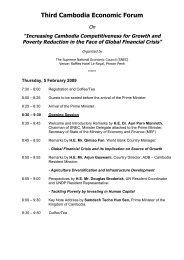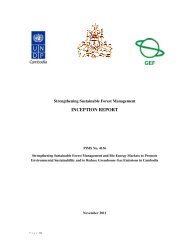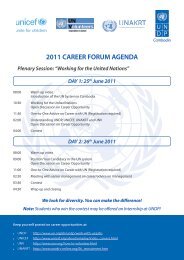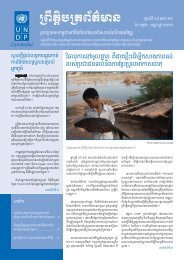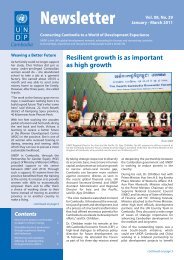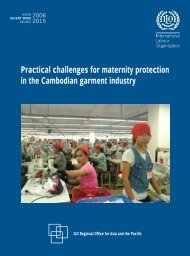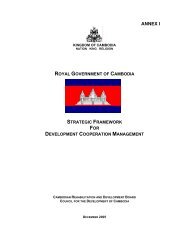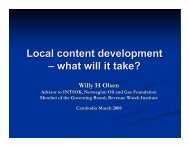UN Analysis Final.pdf - United Nations in Cambodia
UN Analysis Final.pdf - United Nations in Cambodia
UN Analysis Final.pdf - United Nations in Cambodia
You also want an ePaper? Increase the reach of your titles
YUMPU automatically turns print PDFs into web optimized ePapers that Google loves.
The implications of this data are that a large proportion of youth with low skills and poor educational<br />
backgrounds will have very limited opportunities to work as wage labourers <strong>in</strong> either the formal or <strong>in</strong>formal<br />
economies. In addition, rural youths are likely to suffer more from hav<strong>in</strong>g low-paid jobs and rema<strong>in</strong><strong>in</strong>g at risk<br />
from hav<strong>in</strong>g to migrate to urban and border areas.<br />
Overall, the employment prospects for males are better than for females, and this is true even <strong>in</strong> the garment<br />
<strong>in</strong>dustry, which disproportionately employs females,the difference is almost 7 per cent. (table 5-9). Available<br />
jobs for male youths are predom<strong>in</strong>antly found <strong>in</strong> construction or sell<strong>in</strong>g their labour. Demand for female<br />
workers appears to lie more <strong>in</strong> the area of unpaid jobs as family helpers, which puts them at the bottom <strong>in</strong> the<br />
conventional occupational ladder, and, at the same time, <strong>in</strong> terms of <strong>in</strong>come and status <strong>in</strong> the labour market.<br />
Table 5-9. Labour force by gender, location and employment status<br />
Employees<br />
Employers<br />
Own Account<br />
Workers<br />
Unpaid family<br />
helpers<br />
<strong>Cambodia</strong><br />
Both sexes 20.0 0.1 34.4 43.3 2.3 100<br />
Male 23.3 0.1 39.7 34.8 1.2 100<br />
Female 16.6 0.1 28.8 52.0 2.5 100<br />
Phnom Penh<br />
Both sexes 48.0 0.1 27.1 22.9 1.9 100<br />
Male 56.3 0 23.5 18.7 2.4 100<br />
Female 39.1 0.1 31 27.4 2.4 100<br />
Other Urban<br />
Both sexes 26.3 0.2 34.5 36.5 2.6 100<br />
Male 32.6 0.3 36.3 28.8 2.1 100<br />
Female 19.5 0 32.6 44.7 3.1 100<br />
Rural<br />
Both sexes 16.7 0.1 35 46 2.3 100<br />
Male 19.1 0.1 41.7 37.1 2 100<br />
Female 14.3 0.1 28.2 55 2.4 100<br />
Source: CSES 2004<br />
Other<br />
Total<br />
5.2.2 <strong>UN</strong>EMPLOYED YOUTH<br />
Unemployment <strong>in</strong> Phnom Penh <strong>in</strong> 2004 among 15-19 year-olds was 6.2 per cent, with little gender variation<br />
(CSES 2004). The rates were slightly higher for those aged 20-24, nearly 8 per cent (9.3 per cent for males<br />
and 6.5 per cent for females). Interest<strong>in</strong>gly, unemployment rates <strong>in</strong> rural areas are much lower at 0.8 per<br />
cent overall. The relatively higher unemployment rates of youths <strong>in</strong> Phnom Penh and other urban areas may<br />
reflect rural-to-urban migration <strong>in</strong> search of employment. Likewise, <strong>in</strong> low technology agriculture, there<br />
appears still to be room for ‘one more pair of hands’.<br />
When consider<strong>in</strong>g youth unemployment, its def<strong>in</strong>ition becomes important. Specifically, <strong>in</strong> the strictest<br />
def<strong>in</strong>ition (“not work<strong>in</strong>g even for one hour last week and seek<strong>in</strong>g work”), youth unemployment appears to<br />
be low. However if a more relaxed def<strong>in</strong>ition (“those not work<strong>in</strong>g but available to work”) is used, a somewhat<br />
different picture emerges (Table 5-10). Us<strong>in</strong>g this def<strong>in</strong>ition, the highest rates of unemployment appear to<br />
also occur among educated youth.<br />
58 Situation <strong>Analysis</strong> of Youth <strong>in</strong> <strong>Cambodia</strong>




